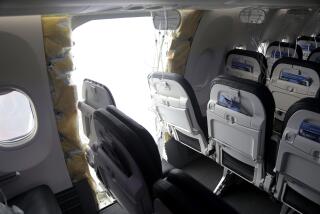Dreamliner gets a big rollout in Long Beach
Gov. Jerry Brown sat down in the captain’s chair inside the cockpit of a Boeing C-17 Globemaster III cargo jet and gazed at an array of gauges and dials spread out before him.
At one point he turned to Bob Ciesla, Boeing’s C-17 program manager, and asked: “Is this where it’s built?”
Ciesla confirmed that Long Beach was the manufacturing site — and that the company has struggled in recent years to keep the plant operating. He didn’t seem to mind that the governor did not know that the military’s workhorse cargo jet has been built here since the early 1990s.
“The governor has a lot on his plate,” Ciesla said later.
Brown spokeswoman Elizabeth Ashford agreed, saying that with all the running around that Brown does, “he must have gotten mixed up.”
The C-17 was sitting nose to nose with Boeing’s much anticipated 787 Dreamliner on a tarmac outside the Long Beach plant. Brown joined hundreds of Boeing employees, aerospace executives and state and local politicians assembled there to get a firsthand look at the hot-selling aircraft that’s been carrying passengers internationally since the first of them were delivered to All Nippon Airways in September.
Although the governor heralded the Dreamliner as the first commercial plane of the 21st century, U.S. carriers have not yet received the jet, which costs $185 million to $218 million depending on the version ordered.
Boeing has taken 870 orders for the Dreamliner, making it one of the biggest-selling planes ever built. The Dreamliner was once expected by May 2008, but saw its delivery date pushed back several times because of design problems and supplier issues.
Still, airlines have been eager to get their hands on the plane because of new fuel-efficient engines and a lighter-weight body largely made of composite materials — carbon fibers meshed together with epoxy — instead of sheets of aluminum. Boeing has promised airlines that the technology will result in a plane that burns 20% less fuel than jetliners of a similar size.
Major parts for the plane are pre-assembled all over the globe and then shipped to Everett, Wash., where they are “snapped together” in three days, compared with a month when done the traditional way. In years past, workers would assemble and wire the entire plane at the factory.
Factories in Southern California, Russia, Japan and Italy supplied parts for the aircraft. That’s why Boeing said it was holding a Dream Tour to show off the handiwork in scores of cities across the globe. There are about 50 suppliers in California alone.
“It’s a wonderful opportunity to show customers and suppliers the aircraft,” said Capt. Thomas Griffin, a Boeing pilot. “We had a guy that supplied toilets go in and take a bunch of pictures of the bathroom. It was great.”
Brown took a personal tour of the Dreamliner, guided by Boeing officials. He asked questions about the plane’s wider windows and soft “blue-sky lighting” that illuminates in the cabin rather than white fluorescent lights.
After the 787 walk-through, Brown made a speech in front of a cavernous C-17 hangar — a facility that faces a less than promising future.
One by one, workers in blue jumpsuits began trickling out of the 1-million-square-foot facility to see the new Dreamliner — the third ever made by Boeing — decked out in white and blue paint. Some of the 6,000 Boeing workers employed in Long Beach also came to hear the governor’s speech.
Brown focused on California’s contribution to the Dreamliner. He spoke very little about the beleaguered jet-making complex in front of him. In recent years, Boeing has slashed the number of employees at the C-17 plant and slowed production rates to 10 aircraft a year from 15 to draw out the assembly line’s life. Without new orders, production is scheduled to cease in 2014.
The C-17 is the Air Force’s massive, four-engine jet that hauls 60-ton tanks, troops and medical gear across continents and yet lands on short runways. With tight Pentagon budgets, the Air Force stopped ordering C-17s in 2006. Since then, Congress has made last-minute earmarks to keep the plant rolling.
Additionally, Boeing has been pushing foreign sales to help prolong the production line, but because these orders are small — about five planes at a time — they have not been enough to sustain the production line.
The plant, near Long Beach Airport, is the last complete conventional airplane-making assembly line in Southern California. It is a symbol of a bygone era in the Southland when factories ran around the clock building colossal aircraft.







